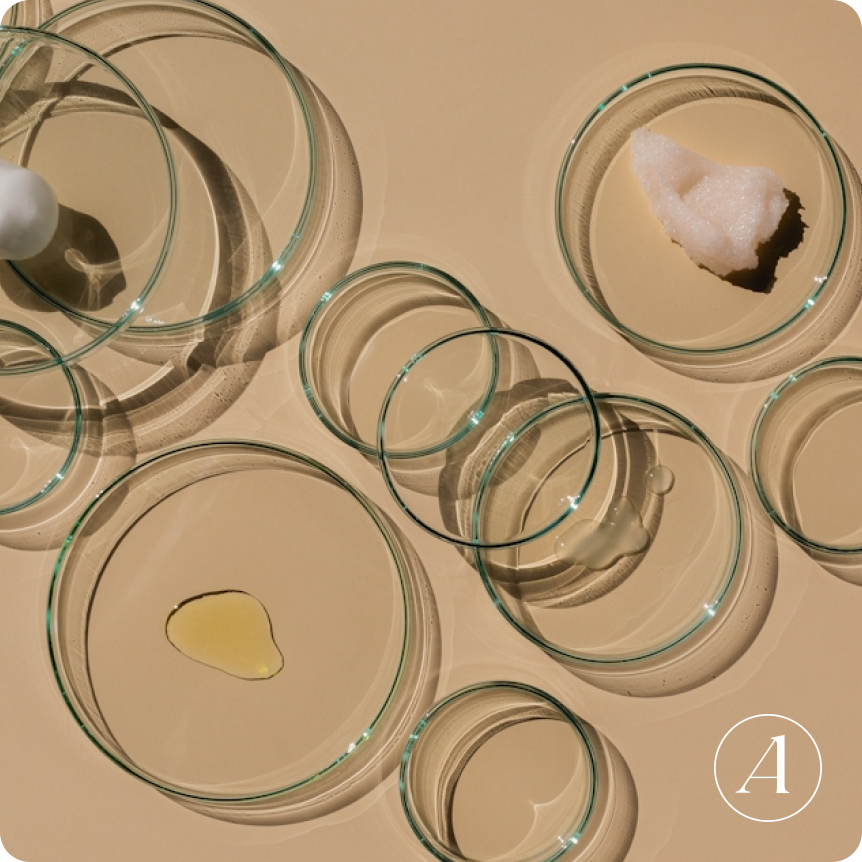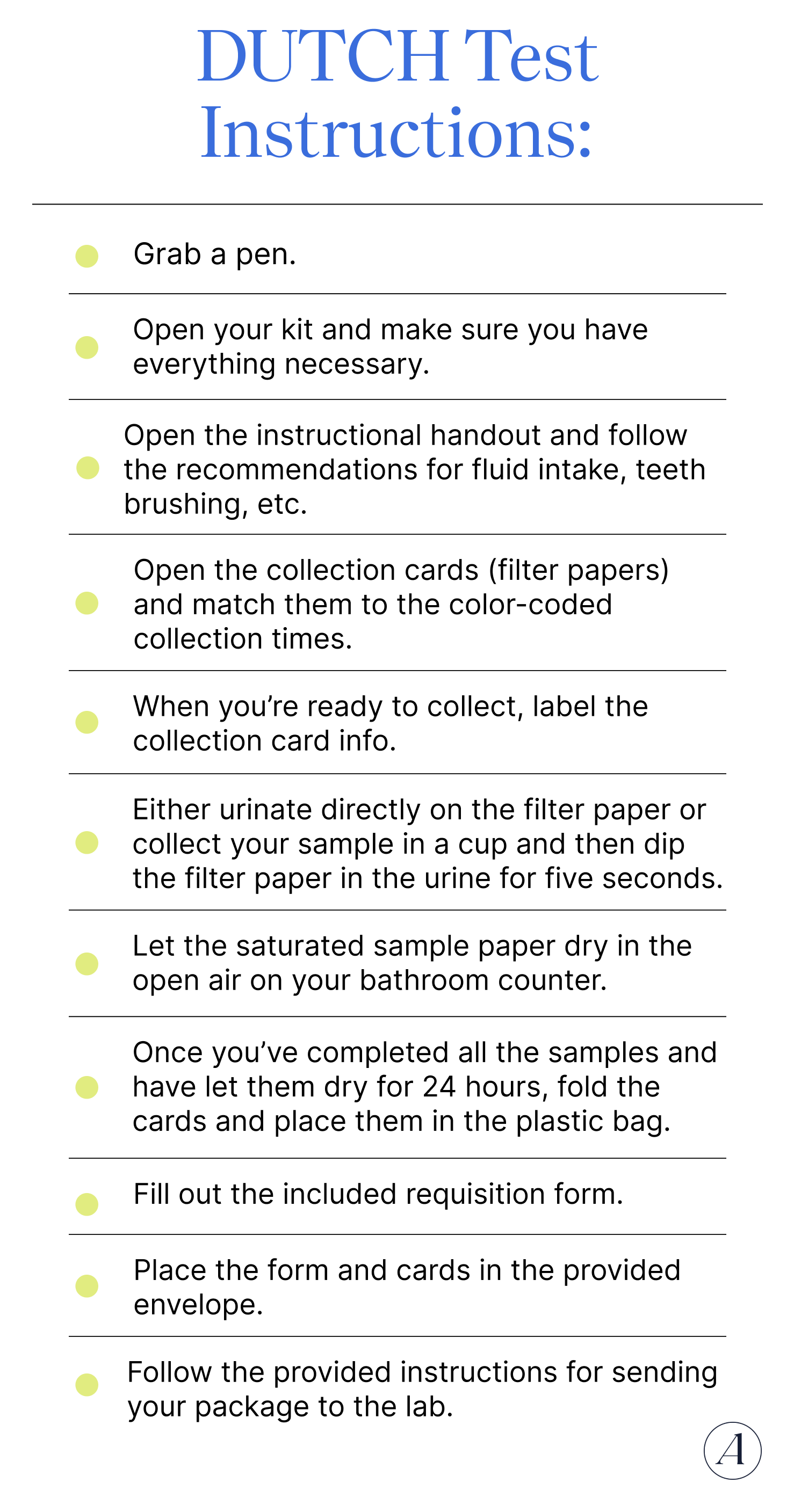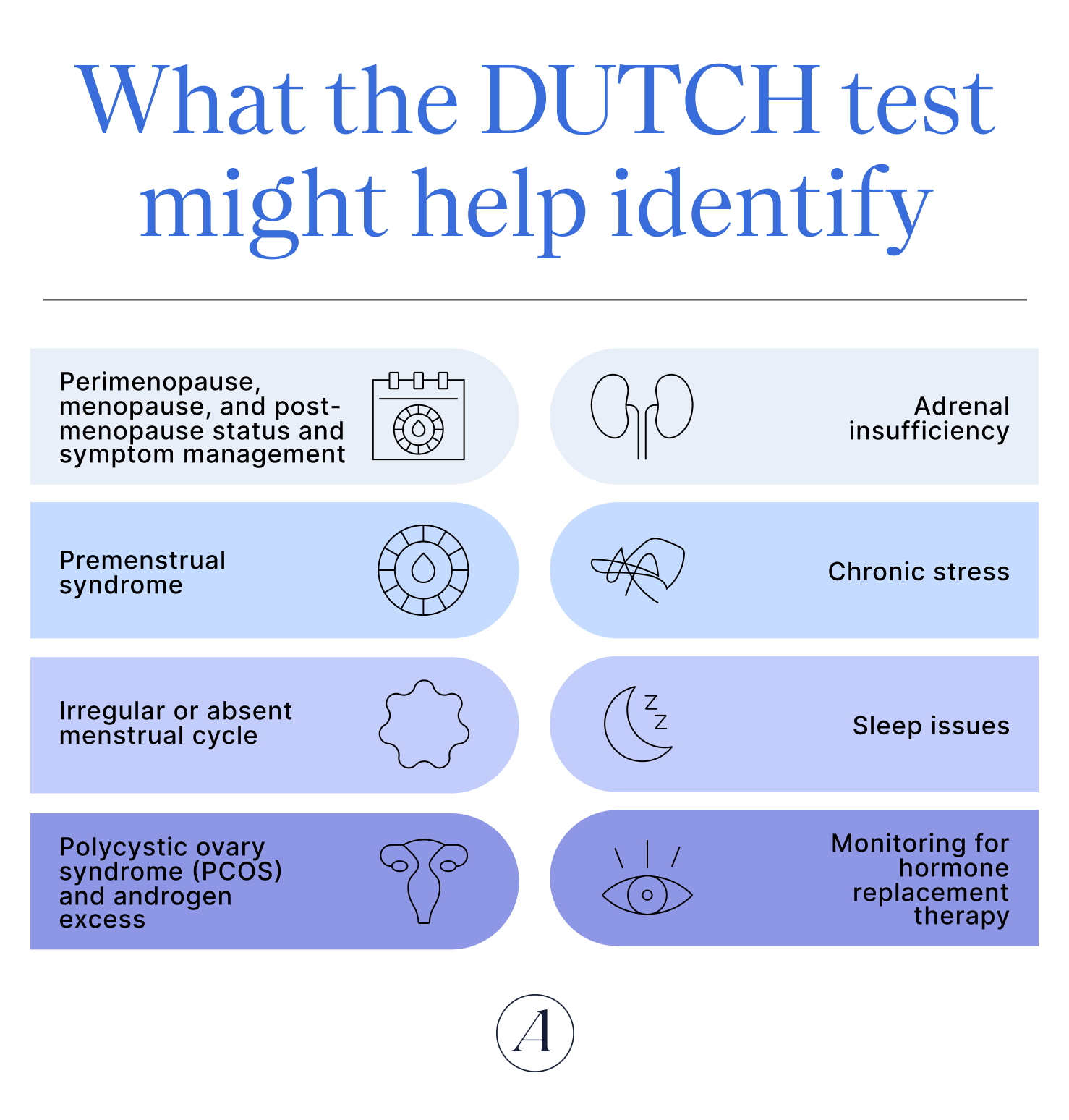
The DUTCH Test: Is It Worth it?
The Dutch Test (Dried Urine Test for Comprehensive Hormones) tests your reproductive hormones, stress and sleep hormones, hormone metabolites, and other biomarkers. But it lacks robust independent evidence supporting its validity. What gives?
Your hormones, especially sex hormones, play crucial roles in your health beyond just reproduction and sexual function. Hormonal imbalances can lead to fatigue, mood swings, difficulty with weight management, and more. That’s why many people turn to hormone testing to see what might be up.
The DUTCH hormone test came on the scene about a decade ago, offering a different approach than traditional blood, urine, and saliva tests.
“The DUTCH test examines not only hormone levels and their patterns over 24 hours, but also how the body is metabolizing those hormones,” says Dawn Derrick, a nurse practitioner with Derrick Health.
But what is it, what does the DUTCH test for hormones measure, and is it legitimate?
What is the DUTCH test?
DUTCH is an acronym that stands for Dried Urine Test for Comprehensive Hormones. Precision Analytical, founded by Mark Newman, MS, created the test, which has been around since 2012.
The DUTCH test is an at-home hormone test that uses samples of your dried urine throughout the day. It allows lab technicians to assess your sex hormones, cortisol levels, and additional biomarkers, such as organic acids.
The makers of the DUTCH urine test say the panel provides a more comprehensive look at hormone metabolism than traditional tests. However, the test lacks backing from independent, peer-reviewed studies to substantiate these claims. Still, some providers use it in context with other tests.
The instructions vary based on which DUTCH test you take. For example, you can take a 24-hour test with five urine collections, or one that provides a picture of your overall menstrual cycle (DUTCH Cycle Mapping) via nine urine collections.
The DUTCH test costs $300 to $700, depending on the type of test.

To take the DUTCH Complete panel, you collect four to five urine samples over a 24-hour period.
- Before dinner (about 5 p.m.)
- Bedtime (about 10 p.m.)
- Middle of the night (optional)
- Upon waking (within 10 minutes)
- Two hours after waking
The test kit includes five filter papers. You can either pee directly on the filter paper or collect urine in a clean cup and then dip the paper into the sample to saturate before letting it dry. Once dried, you ship the kit back to a lab for analysis.
Prep and what to avoid:
- If you menstruate and have a 28-day cycle, choose a day between 19 and 22 of your cycle for collection. If you have a shorter or longer cycle add or subtract days to or from the range accordingly. For example, if you have a 30-day cycle, collect between days 21 and 24. If you have a 26-day cycle, collect between days 17 and 20.
- Limit your total fluid intake to 32 to 64 ounces and avoid alcohol and caffeine on the day you start testing at dinnertime and on the next morning until you’ve completed the remaining two tests.
- For 48 hours before the test, avoid avocados, bananas, and fava beans.
What does the DUTCH test measure?
DUTCH testing measures sex hormones, adrenal hormones, and organic acids (OATS).
Sex hormones
The tested sex hormones include the different types of estrogen (estrone, estradiol, and estriol), progesterone, and androgens (including testosterone). The test also measures metabolites (byproducts) and some precursors ( a chemical that reacts to produce another) of these hormones.
Adrenal hormones
The adrenal glands, located atop of each kidney, produce key hormones, including cortisol, the “stress hormone.” The DUTCH test measures cortisol and its metabolites, and cortisone, the less active form of cortisol.
The adrenals also produce Dehydroepiandrosterone sulfate (DHEA-S), a hormone that acts as a precursor to estrogen, testosterone, and other hormones, so the DUTCH test investigates this hormone as well.
And it measures creatinine, a byproduct of muscle tissue breakdown. Although not a hormone itself, creatinine when elevated can signal an issue, such as adrenal crisis when extreme. Adrenal crisis is a complication from conditions such as adrenal insufficiency, where the adrenal glands produce an inadequate amount of hormones. The DUTCH test cannot diagnose adrenal crisis, so if you’re curious about your creatine levels, talk to your provider.
The DUTCH test investigates your melatonin, the “sleep hormone,” as well. The pineal gland in the brain produces melatonin, and its level can influence the production of DHEA-S and cortisol.
Organic acid tests (OATs)
Organic acids are byproducts of metabolic processes. Organic acid tests (OATs) can help determine if you have nutritional deficiencies or issues with metabolism or neurotransmitters. The DUTCH test examines markers and metabolites for the following:
- Vitamin B12
- Vitamin B6
- Biotin
- Glutathione
- Indican (a biomarker of gut imbalance)
- Dopamine
- Norepinephrine/epinephrine
- Quinolinate (a marker of neuroinflammation)
- Oxidative stress/DNA damage
DUTCH test benefits
The makers of the DUTCH cite several benefits of its use. First, you can take the test at home rather than in a lab or clinic. But the benefits may go beyond convenience, according to the manufacturers.
The DUTCH test looks at hormones over 24 hours
Single-sample blood, urine, and saliva tests offer just a snapshot of a hormone level at the time of the test. Yet, our hormone levels fluctuate throughout the day. The DUTCH test involves five tests over 24 hours. Or you can take the DUTCH Cycle Mapping test throughout your menstrual cycle.
The DUTCH test checks metabolites
Hormones in their active form, act as chemical messengers for various bodily processes. But after they exert their effects, they become inactive, and the body needs more. It clears the inactive hormones through urine. But the liver and kidneys must break them down, producing metabolites. These metabolites are what end up in the urine. And they can offer insight into how well the body is producing, using, and excreting hormones.
The manufacturers say, “Testing these metabolites can give healthcare practitioners an in-depth picture of why their patient’s overall hormones are elevated, lacking, or point toward specific symptoms.”
The DUTCH test looks at hormones in context
The DUTCH test analyzes sex hormones along with adrenal hormones, hormone metabolites, and OATs. This is because adrenal hormones and sex hormones interact. And additional metabolites and OATs can help a provider understand hormones in context with each other along with other biomarkers that affect health or signal a health concern. The makers of the Dutch test argue that OAT testing provides a more comprehensive hormone panel.
“OATs can round out hormone testing in a way that provides additional information about the nutritional status, gut, and brain health of a patient,” the manufacturers say.

DUTCH test limitations
The DUTCH test sounds great in theory. However, you may be asking yourself, “Is the DUTCH test legitimate? What are its limitations?”
The test is not FDA-cleared
The Food and Drug Administration (FDA) is responsible for “clearing” devices and tests, but it has not cleared the DUTCH test.
The DUTCH test lacks independent research
The test has undergone some peer-reviewed studies that support its validity. But, Newman, the founder of the test, conducted the research himself, therefore it wasn’t an independent evaluation.
“Traditional medical providers may be skeptical of DUTCH testing because it’s not part of traditional medical guidelines and there are no large randomized controlled trials (RCTs) validating its use,” Derrick says.
“Interpretation requires advanced training—also not standardized—which can make finding a reliable practitioner challenging,” she adds.
Providers have concerns about the DUTCH test’s validity
“The test also involves analyzing hormones in urine, and the results are not always the same by accuracy and consistency as blood tests,” says David Ghozland, MD, an OBYGYN.
“It furthermore brings extensive data about the metabolites of the hormones but lacks immediate correlation with clinical [and] patient actionable outcomes,” he says. “This creates a lot of reservation among the providers because the test might end up over-diagnosing or subjecting them to treatments that do not necessarily correspond with the symptoms or clinical manifestations.”
While convenient, the at-home collection method also presents some concerns. “The use of home collection kits that is characteristic of the Dutch Test might create some doubts regarding the correct manipulation and conservation of the samples, which may interfere with the outcomes,” Dr. Ghozland says. “It may be helpful in clinical practice in the specific situation but its blanket use without clinical importance of the patient could result in misinterpretation especially when the hormonal imbalance has a complex etiology like diet, stress, or drug.”
The DUTCH test is not a diagnostic tool
While the DUTCH test can be used in conjunction with serum and 24-hour urine analysis, the DUTCH test alone can not diagnose adrenal disorders—or complex endocrine disorders. Proponents of the DUTCH test, like Derrick, still maintain that “DUTCH testing can be used to evaluate fatigue, hormone imbalance, adrenal health/stress response, perimenopause and menopause, and hormone replacement therapy (HRT) monitoring”.
The DUTCH test is expensive and may not be covered by insurance
“The DUTCH test is innovative, but has received criticism among providers as being exorbitantly expensive and rather imprecise clinically in certain situations despite its popularity,” Dr. Ghozland says.
The manufacturer states on its FAQ page, “We do not bill or accept payment from insurance and we are considered out of network. If your test is ordered by a provider, and you have out-of-network coverage, you will be able to submit a receipt to your insurance company for possible reimbursement.”
How does DUTCH compare to other hormone tests?
DUTCH test vs. blood test vs. 24-hour urine test vs saliva test: Here’s a breakdown of various forms of hormonal testing.
DUTCH test
This method involves collecting five urine samples in 24 hours on filter paper and letting it dry, then shipping the kit to a lab.
- Pros
- Tests metabolites in additions to hormones
- Convenient (at-home) testing
- Can evaluate hormones throughout the day or cycle
- Cons
- Expensive
- Generally not covered by insurance
- At-home collection could compromise samples
- Interpretation is not standardized
- Lacks research backing its efficacy, validity, and accuracy
- Does not test circulating hormones, such as those found in blood or saliva
Blood testing
Blood testing usually involves going to a clinic or lab for a blood draw, though some at-home test kits also look at blood samples.
- Pros
- Provides accurate level of circulating hormones and is the gold standard
- Usually covered by insurance (especially if an in-lab or in-clinic test)
- Cons
- Requires a needle stick
- Does not capture certain metabolites
- Not great for monitoring hormone replacement therapy
Saliva testing
Saliva testing may occur in a lab or at home. Methods vary; you might spit into a tube or other container or collect saliva on an absorbent pad.
- Pros
- Noninvasive to collect
- Can often be done at home rather than in a lab
- Measures circulating hormones
- Good for monitoring hormone replacement therapy
- Cons
- Factors, such as oral hygiene and food intake can affect testing
- Not useful for detecting all hormones
- Testing methods aren’t always standardized
24-hour urine testing
This collection method involves collecting your urine for 24 hours in a lab- or clinic-provided container at home and then sending it in for interpretation.
- Pros
- Can be evaluated for hormone metabolites
- Looks at urine over 24 hours
- Offers at-home collection convenience
- Cons
- Does not reflect circulating hormones
- Can be cumbersome to collect and ship
Clinical use cases: What the DUTCH test might help identify
Keep in mind that the DUTCH test is not a diagnostic tool. But in the hands of a provider who knows how to interpret results, the test could provide additional insight, in context with diagnostic testing and other tools for the following issues:
- Perimenopause, menopause, and post-menopause status and symptom management
- Premenstrual syndrome
- Irregular or absent menstrual cycle
- Polycystic ovary syndrome (PCOS) and androgen excess
- Adrenal insufficiency
- Chronic stress
- Sleep issues
- Monitoring for hormone replacement therapy
- Fatigue or other unexplained symptoms

Key takeaways
- The DUTCH test is an at-home test kit for collecting dried urine samples you send to a lab.
- It tests sex hormones, sleep and stress hormones (which can affect other hormones), hormone metabolites, and related biomarkers.
- Some providers use the test as an alternative or in conjunction with blood, saliva, or other urine tests, or with additional diagnostic tools or procedures.
- The DUTCH test is not FDA-cleared and lacks robust independent, peer-reviewed evidence for its validity.
FAQ
Is the DUTCH test accurate and clinically validated?
The DUTCH test has undergone some peer-reviewed studies that indicate its accuracy and validity. However, the founder of the test conducted these studies, so they were not independent. The DUTCH test has not been studied in clinical trials and is not an FDA-cleared test.
What does a DUTCH test measure?
The DUTCH Complete panel tests sex hormones (estrogen, progesterone, and testosterone), adrenal hormones (cortisol, cortisone, and DHEA-S), hormone metabolites, and OATs (markers for nutrients, gut health, and more) using dried urine samples. It also examines melatonin, the sleep hormone.
Can men benefit from the DUTCH test, or is it just for women?
Males can take the DUTCH test, as well. However, some products, such as DUTCH Cycle Mapping are only relevant to females.
Do I need a doctor to interpret DUTCH test results, or can I do it myself?
You take the DUTCH test at home by yourself. You collect urine samples on filter paper and send your samples to a lab for analysis. You’ll then receive your results, but you will need a healthcare provider to interpret them.
How much does the DUTCH test cost and is it covered by insurance?
You can order various DUTCH test products, which range from $300 to $700. Health insurance plans do not typically cover the cost or reimburse you for the DUTCH test.
How long does it take to get DUTCH test results?
The general timeframe for receiving your DUTCH test results is two to three weeks.












